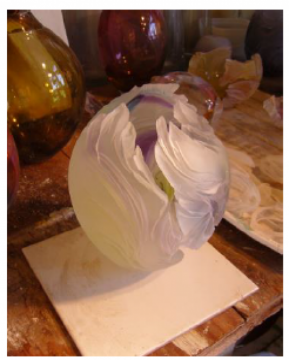If you would like to see more information on this case study, click here!
You can request this case study and a WCDE staff member will get back to you.
Lois Scott is located in Elora, Ontario, Canada, and is one of Canada’s most renowned glass carving artists. Lois carves intricate patterns and shapes into glass vessels that are blown into carious spherical and cylindrical forms. Her pieces are often highly intricate and thus require a great deal of time and effort to create. Each glass piece is individually hand blown, carved and etched. An example of her work is shown in Figure 1. Lois contacted the University of Waterloo to seek help in developing a device to assist her in carrying out her glass carving.

Glass sculpture by Lois Scott
The teaching objective of this case study is to design a glass carving assistive device that does not limit the user’s range of motion, but reduces the apparent weight of the glass vessels and minimizes the effort to sculpt glass. Students will be exposed to the engineering design process including project planning, need analysis, and conceptual design.
If you would like to see more information on this case study, click here!
You can request this case study and a WCDE staff member will get back to you.
Contact Waterloo Cases in Design Engineering
Steve Lambert
Tel: (519) 888-4728
Email: steve@uwaterloo.ca
The University of Waterloo acknowledges that much of our work takes place on the traditional territory of the Neutral, Anishinaabeg, and Haudenosaunee peoples. Our main campus is situated on the Haldimand Tract, the land granted to the Six Nations that includes six miles on each side of the Grand River. Our active work toward reconciliation takes place across our campuses through research, learning, teaching, and community building, and is co-ordinated within the Office of Indigenous Relations.